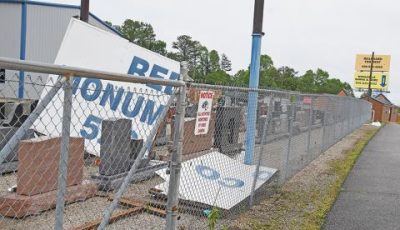Bon Jellico historical marker dedicated

Edde Stout, Jim Stout, Lynn Stenglein, Vickie Sims and Matt Witt all gathered off Highway 92 West Sunday afternoon to dedicate this historical marker commemorating those who worked in the Bon Jellico mine in the 1900’s or those who lived in the adjacent camp. The mine operated for 25 years.
If it wasn’t for the Bon Jellico coal mine and coal camp that operated in the early to mid 1900s near Williamsburg, Emlyn resident Matt Witt might not be alive today. It was the place where his parents first met.
“My grandpa, Alex Nunley, was a coal miner up here. My grandma was named Nan and they had seven kids up here. My mother was born up here,” Witt said about Bon Jellico, which is sometimes also referred to as Bon Hollow. “My daddy hauled coal out of here that’s how he and mother met each other. He had a little old flat bed truck with little rails on the side. He would come up here and buy coal and deliver it. He met my mother and they got married while she lived in Bon Hollow and he moved her to Emlyn.”
Witt was one of a handful of people on hand Sunday afternoon for the dedication of a historical marker recognizing the significance of Bon Jellico in the history of Whitley County.
“I think it’s wonderful thing. It’s beautiful,” Witt said about the historical marker Sunday. “I thought we would never hear any more about it after it closed. My grandmother told tales after tales about what went on up here. I used to come up here and play when I was a kid after the mining camp was gone.”
The Kentucky Historical Society’s historical marker was dedicated Sunday about two miles west of Williamsburg near the intersection of Highway 92W and Bon Hollow Road.

Lynn Stenglein, one of the organizers behind the placement of the Bon Jellico highway marker, spoke during a dedication ceremony Sunday for the marker.
The mine operated from 1912-1937 and employed 350 workers. It produced nearly 100,000 tons of Blue Gem coal annually.
The town around the mine included 75 houses, a three-room school/church and a company store. About 1,500 people lived in Bon Jellico over the 25-year period that the mine operated, according to the Kentucky Historical Society (KHS).
The mine closed primarily because the coal supply was depleted.
Lynn Stenglein, one of the organizers behind the effort to get the historical marker, read a portion of her application letter as part of the dedication ceremony explaining why she did it.
“The local economy of the Whitley County area and hundreds of lives were affected in the 25 years that the Bon workers in the Bon Jellico mines operated. The Bon camp was home to many of the workers and their families. Children of Bon miners became educators, doctors, business people and scientists. They served their country, state and communities,” she read.
“Coal production is declining in southeastern Kentucky. The camps and coal communities are mostly gone. Bon Jellico was returned to forest long ago that is why we mark this location and formally remember the Bon Jellico coal mines, camps, families and cultures.”

Lynn Stenglein, Edde Stout and Vickie Sims all check out a notebook full of Bon Jellico history during the dedication of a historical marker Sunday afternoon.
Another person on hand for Sunday’s dedication ceremony was Jim Stout, whose grandfather, Jim “Red” Stout, and grandmother Tennie Stout, lived at Bon Jellico.
His grandparents migrated to Williamsburg from Crawford, Tennessee, another little coal mining town.
They initially came with a company that migrated to Williamsburg and the Gatliff area, but ended up settling in Bon Jellico.
“My father was born here. The Stouts have a long history with Bon Jellico. There are a lot of good people that grew up here and lived here. It is great to see something put up in their memory,” Stout noted.
For more information about the Bon Jellico log onto http://www.kykinfolk.com/bonjellico.








